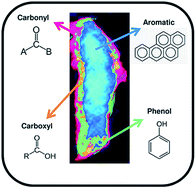Nanoscale mapping of carbon oxidation in pyrogenic black carbon from ancient Amazonian anthrosols†
Abstract
Understanding soil organic matter is necessary for the development of soil amendments, which are important for sustaining agriculture in humid tropical climates. Ancient Amazonian anthrosols are uniquely high in black recalcitrant carbon, making them extremely fertile. In this study, we use high-resolution electron microscopy and spectroscopy to resolve the oxidation process of carbon in the nanoscale crystallites within the black carbon grains of this special soil. Most alkali and acid chemical extraction methods are known to cause chemical modifications in soil organic matter and to give poor or no information about the real spatial structure of soil aggregates. However, here we show that carbon–oxygen functional groups such as phenol, carbonyl, and carboxyl dominate over different spatial regions, with areas varying from over tens to hundreds of nm2. The chemical maps show that in the nanoscale grain, the surface has a tendency to be less aromatic than the grain core, where higher oxidative-degradation levels are indicated by the presence of carbonyl and carboxyl groups. A deep understanding of these structures could allow artificial reproduction of these natural events.


 Please wait while we load your content...
Please wait while we load your content...